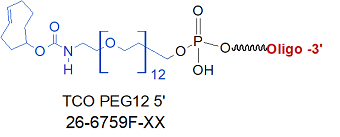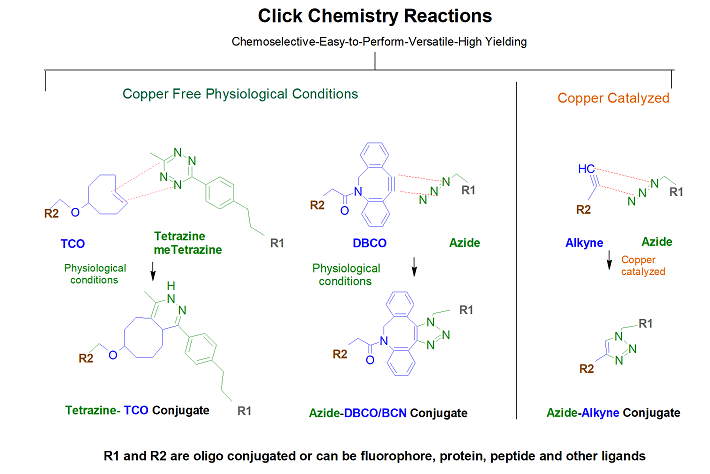
Modification : TCO-PEG12 5'
Catalog Reference Number
Category
Modification Code
5 Prime
3 Prime
Internal
Molecular Weight (mw)
Extinction Coeficient (ec)
Technical Info (pdf)
Absorbance MAX
Emission MAX
Absorbance EC
26-6759F
Click Chemistry
[TCO-PEG12-5]
Y
N
N
752.93
-
PS26-6759F.pdf
-
-
-
| Catalog No | Scale | Price |
| 26-6759F-05 | 50 nmol | $865.00 |
| 26-6759F-02 | 200 nmol | $865.00 |
| 26-6759F-01 | 1 umol | $920.00 |
| 26-6759F-03 | 2 umol | $1,415.00 |
| 26-6759F-06 | 5 umol | $2,844.00 |
| 26-6759F-10 | 10 umol | $4,465.00 |
| 26-6759F-15 | 15 umol | $4,965.00 |
| Discounts are available for TCO-PEG12 5'! |
| Modification* Discount Price Structure |
|
1 site/order
|
List price
|
|
2 sites/order
|
10% discount
|
|
3 sites/order
|
20% discount
|
|
4 sites/order
|
30% discount
|
|
5-9 sites/order
|
50% discount
|
|
10+ sites/order
|
60% discount
|
|
*Exceptions apply
|
Click here for a complete list of Click Chemistry Oligo Modifications
TCO (trans-cyclooctene) PEG12 is for 5' modification to introduce an active TCO group to an oligonucleotide. It includes a long PEG12 spacer between the 5' end of the oligo and the active TCO group.
The TCO (trans-cyclooctene) modification is known for its high internal strain on the double bond, facilitating the Strain-Promoted Inverse Electron-Demand Diels-Alder Reaction (SPIEDAC) with tetrazine derivatives. This is also known as an inverse electron-demand Diels-Alder, (IEDDA) cycloaddition.
A tetrazine (acting as a diene) rapidly reacts with a trans-cyclooctene (TCO, acting as a dienophile) to form a cyclic adduct, followed by a subsequent retro-Diels-Alder reaction that eliminates nitrogen gas, leaving behind a stable conjugated product; essentially, a very fast "click" reaction often used in bioorthogonal chemistry due to its high speed and specificity in aqueous environments This reaction proceeds selectively even in the presence of various functional groups, making it applicable as a click chemistry tool. Click chemistry utilizing TCO does not require metal catalysts and exhibits rapid reaction rates as its primary feature. This click chemistry meets the criteria for bioorthogonal reactions (fast, selective, biocompatible, metal-free) and finds applications in a wide range of uses such as protein labeling and imaging.
 References
References
1. Huisgen, R.
Angew. Chem. Int. Ed. (1963),
2: 565-568.
2. Rostovtsev, V.V., Green, L.G., Fokin, V.V., Sharpless, K.B. A Stepwise Huisgen Cycloaddition Process: Copper(I)-Catalyzed Regioselective Ligation of Azides and Terminal Alkynes.
Angew. Chem. Int. Ed. (2002),
41: 2596-2599.
3. Kumar, R., El-Sagheer, A., Tumpane, J., Lincoln, P., Wilhelmsson, L.M., Brown, T. Template-Directed Oligonucleotide Strand Ligation, Covalent Intramolecular DNA Circularization and Catenation Using Click Chemistry.
J. Am. Chem. Soc. (2007),
129: 6859-6864.
- TCO-PEG12 5' Oligo
